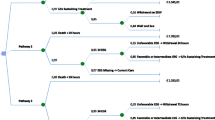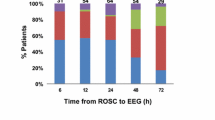Abstract
Electroencephalography (EEG) is used to prognosticate recovery in comatose patients with hypoxic ischemic brain injury (HIBI) secondary to cardiac arrest. We sought to determine the prognostic use of specific EEG patterns for predicting disability and death following HIBI secondary to cardiac arrest. This systematic review searched Medline, Embase, and Cochrane Central up to January 2020. We included original research involving prospective and retrospective cohort studies relating specific EEG patterns to disability and death in comatose adult patients suffering HIBI post cardiac arrest requiring admission to an intensive care setting. We evaluated study quality using the Quality of Diagnostic Accuracy Studies 2 tool. Descriptive statistics were used to summarize study, patient, and EEG characteristics. We pooled study-level estimates of sensitivity and specificity for EEG patterns defined a priori using a random effect bivariate and univariate meta-analysis when appropriate. Funnel plots were used to assess publication bias. Of 5191 abstracts, 333 were reviewed in full text, of which 57 were included in the systematic review and 32 in meta-analyses. No reported EEG pattern was found to be invariably associated with death or disability across all studies. Pooled specificities of status epilepticus, burst suppression, and electrocerebral silence were high (92–99%), but sensitivities were low (6–39%) when predicting a composite outcome of disability and death. Study quality varied depending on domain; patient flow and timing performed was well conducted in all, whereas EEG interpretation was retrospective in 17 of 39 studies. Accounting for variable study quality, EEG demonstrates high specificity with a low risk of false negative outcome attribution for disability and death when status epilepticus, burst suppression, or electrocerebral silence is detected. Increased use of standardized cross-study protocols and definitions of EEG patterns are required to better evaluate the prognostic use of EEG for comatose patients with HIBI following cardiac arrest.





Similar content being viewed by others
References
Chan PS, McNally B, Tang F, Kellermann A. CARES surveillance group. recent trends in survival from out-of-hospital cardiac arrest in the United States. Circulation. 2014;130(21):1876–82.
Dragancea I, Rundgren M, Englund E, Friberg H, Cronberg T. The influence of induced hypothermia and delayed prognostication on the mode of death after cardiac arrest. Resuscitation. 2013;84(3):337–42.
Temple A, Porter R. Predicting neurological outcome and survival after cardiac arrest. Contin Educ Anaesth Crit Care Pain. 2012;12(6):283–7.
Westhall E, Rossetti AO, van Rootselaar A-F, Wesenberg Kjaer T, Horn J, Ullén S, et al. Standardized EEG interpretation accurately predicts prognosis after cardiac arrest. Neurology. 2016;86(16):1482–90.
Hirsch LJ, Laroche SM, Gaspard N, Gerard E, Svoronos A, Herman ST, et al. American clinical neurophysiology society’s standardized critical care EEG terminology: 2012 version.
Whiting PF, Rutjes AWS, Westwood ME, Mallett S, Deeks JJ, Reitsma JB, et al. QUADAS-2: a revised tool for the quality assessment of diagnostic accuracy studies. Ann Intern Med. 2011;155(8):529.
Deeks JJ, Macaskill P, Irwig L. The performance of tests of publication bias and other sample size effects in systematic reviews of diagnostic test accuracy was assessed. J Clin Epidemiol. 2005;58(9):882–93.
Rutter CM, Gatsonis CA. A hierarchical regression approach to meta-analysis of diagnostic test accuracy evaluations. Stat Med. 2001;20(19):2865–84.
Halligan S, Altman DG, Mallett S. Disadvantages of using the area under the receiver operating characteristic curve to assess imaging tests: a discussion and proposal for an alternative approach. Eur Radiol. 2015;25(4):932–9.
Mallett S, Halligan S, Collins GS, Altman DG. Exploration of analysis methods for diagnostic imaging tests: problems with ROC AUC and confidence scores in CT colonography. PLoS One. 2014;9(10):e107633.
Takwoingi Y, Guo B, Riley RD, Deeks JJ. Performance of methods for meta-analysis of diagnostic test accuracy with few studies or sparse data.
Guo J, Riebler A (2018) Meta4diag: bayesian bivariate meta-analysis of diagnostic test studies for routine practice. J Stat Softw 2018;83(1).
Stata Statistical Software: Release 13 [computer program]. Coll Stn StataCorp; 2013.
The Nordic Cochrane Centre. The cochrane collaboration [computer program]. Version 5.2.3. Copenhagen: The Nordic Cochrane Centre; 2012.
Sandroni C, D’Arrigo S, Nolan JP. Prognostication after cardiac arrest. Crit Care. 2018;22(1):150.
Wijdicks EFM, Hijdra A, Young GB, Bassetti CL, Wiebe S. Practice parameter: prediction of outcome in comatose survivors after cardiopulmonary resuscitation (an evidence-based review). 2006.
Nielsen N, Stammet P, van Rootselaar A-F, Åneman A, Hovdenes J, Wesenberg Kjaer T, et al. Standardized EEG interpretation accurately predicts prognosis after cardiac arrest. Neurology. 2016;86(16):1482–90.
Sondag L, Ruijter BJ, Tjepkema-Cloostermans MC, Beishuizen A, Bosch FH, van Til JA, et al. Early EEG for outcome prediction of postanoxic coma: prospective cohort study with cost-minimization analysis. Crit Care. 2017;21(1):111.
Ruijter BJ, van Putten MJAM, van den Bergh WM, Tromp SC, Hofmeijer J. Propofol does not affect the reliability of early EEG for outcome prediction of comatose patients after cardiac arrest. Clin Neurophysiol. 2019;130(8):1263–70.
Sandroni C, D’Arrigo S, Cacciola S, Hoedemaekers CWE, Kamps MJA, Oddo M, et al. Prediction of poor neurological outcome in comatose survivors of cardiac arrest: a systematic review Key messages from the 2020 evidence review. This review follows those published previously in 2013 and will inform the upcoming European resuscitation council and European society of intensive care medi-cine (ERC-ESICM) guidelines on post-resuscitation. Intensive Care Med. 2020;46:1803–51.
Nolan JP, Sandroni C, Böttiger BW, Cariou A, Cronberg T, Friberg H, et al. European resuscitation council and european society of intensive care medicine guidelines 2021: post-resuscitation care. Intensive Care Med. 2021;47(4):369–421.
Hirsch LJ, LaRoche SM, Gaspard N, Gerard E, Svoronos A, Herman ST, et al. American clinical neurophysiology society’s standardized critical care EEG terminology. J Clin Neurophysiol. 2013;30(1):1–27.
Alvarez V, Sierra-Marcos A, Oddo M, Rossetti AO. Yield of intermittent versus continuous EEG in comatose survivors of cardiac arrest treated with hypothermia. Crit Care. 2013;17(5):R190.
Claassen J, Mayer SA, Kowalski RG, Emerson RG, Hirsch LJ. Detection of electrographic seizures with continuous EEG monitoring in critically ill patients. Neurology. 2004;62(10):1743–8.
Ruijter BJ, van Putten MJ, Horn J, Blans MJ, Beishuizen A, van Rootselaar A-F, et al. Treatment of electroencephalographic status epilepticus after cardiopulmonary resuscitation (TELSTAR): study protocol for a randomized controlled trial. Trials. 2014;15(1):433.
Hofmeijer J, Tjepkema-Cloostermans MC, van Putten MJAM. Burst-suppression with identical bursts: a distinct EEG pattern with poor outcome in postanoxic coma. Clin Neurophysiol. 2014;125(5):947–54.
Acknowledgements
NJ is the Icahn School of Medicine at Mount Sinai Bludhorn Professor of International Medicine. The authors thank Edilberto Amorim, MD (Department of Neurology, Massachusetts General Hospital, Boston, MA, USA), Jeannette Hofmeijer, MD, and her research group (Department of Neurology, Rijnsate Hospital, Wagnerlaan, Arnhem, The Netherlands), and Hitoshi Kobata, MD (Neurosurgery, Osaka Mishima Emergency Critical Care Center, Osaka, Japan), for their correspondence and willingness to share/clarify their data.
Funding
This study received no funding.
Author information
Authors and Affiliations
Contributions
KP and CJ came up with the study concept. All authors contributed to the study design. KP, SK, MW, and CJ collected and analyzed the data. KP and CB wrote the first draft of the article and all authors commented on previous versions of the article. All authors read and approved the final manuscript.
Corresponding author
Ethics declarations
Conflicts of interest
Dr. Tolulope Sajobi is supported by the MSI Foundation New Investigator Grant. Dr. Nathalie Jette receives grant funding paid to her institution for grants unrelated to this work from NINDS (NIH U24NS107201, NIH IU54NS100064). She receives a stipend as an Associate Editor of Epilepsia. Dr. Samuel Wiebe held the Hopewell Professorship of Clinical Neurosciences Research at the University of Calgary. Dr. Colin Josephson has received unrestricted educational grants unrelated to this work from UCB Canada Inc. and Eisai Inc. The remaining authors reports no disclosures or conflicts of interests.
Ethical approval/informed consent
All authors confirm that we have read the journal’s position on issues involved in ethical publication and affirm that this report is consistent with those guidelines.
Additional information
Publisher's Note
Springer Nature remains neutral with regard to jurisdictional claims in published maps and institutional affiliations.
Supplementary Information
Below is the link to the electronic supplementary material.
12028_2021_1322_MOESM6_ESM.pdf
Stratified forest plot of the sensitivity and specificity of burst suppression predicting composite outcomes 24 hours before cardiac arrest. (PDF 81 KB)
12028_2021_1322_MOESM7_ESM.pdf
Stratified forest plot of the sensitivity and specificity of burst suppression predicting composite outcomes 24 hours after cardiac arrest. (PDF 47 KB)
12028_2021_1322_MOESM8_ESM.png
Hierarchical summary receiver operating curve for burst suppression predicting death in patients with hypoxic ischemic brain injury following cardiac arrest. (PNG 6 KB)
12028_2021_1322_MOESM9_ESM.pdf
Stratified forest plot of the sensitivity and specificity of burst suppression predicting death in patients with hypoxic ischemic brain injury following cardiac arrest. (PDF 55 KB)
12028_2021_1322_MOESM10_ESM.pdf
Hierarchical summary receiver operating curve for electrocerebral silence predicting composite outcomes of disability and death in patients with hypoxic ischemic brain injury following cardiac arrest. (PDF 13 KB)
12028_2021_1322_MOESM11_ESM.pdf
Stratified forest plot of the sensitivity and specificity of electrocerebral silence predicting composite outcomes in patients with hypoxic ischemic brain injury within the first 24 hours of cardiac arrest. (PDF 18 KB)
12028_2021_1322_MOESM12_ESM.pdf
Hierarchical summary receiver operating curve for electrocerebral silence predicting death alone in patients with hypoxic ischemic brain injury following cardiac arrest. (PDF 67 KB)
12028_2021_1322_MOESM13_ESM.pdf
Stratified forest plot of the sensitivity and specificity of electrocerebral silence predicting death in patients with hypoxic ischemic brain injury following of cardiac arrest. (PDF 59 KB)
12028_2021_1322_MOESM14_ESM.pdf
Hierarchical summary receiver operating curve for status epilepticus in predicting a composite outcome of disability and death in patients with hypoxic ischemic brain injury within the first 24 hours cardiac arrest. (PDF 70 KB)
12028_2021_1322_MOESM15_ESM.pdf
Stratified forest plot of the sensitivity and specificity of status epilepticus predicting composite outcomes in patients with hypoxic ischemic brain injury following of cardiac arrest. (PDF 74 KB)
12028_2021_1322_MOESM16_ESM.pdf
Hierarchical summary receiver operating curve for status epilepticus in predicting death in patients with hypoxic ischemic brain injury within the first 24 hours cardiac arrest. (PDF 5 KB)
12028_2021_1322_MOESM17_ESM.pdf
Stratified forest plot of the sensitivity and specificity of status epilepticus predicting death in patients with hypoxic ischemic brain injury following of cardiac arrest. (PDF 51 KB)
12028_2021_1322_MOESM18_ESM.pdf
Hierarchical summary receiver operating curve for generalized periodic discharges in predicting composite of death and disability in patients with hypoxic ischemic brain injury. (PDF 71 KB)
12028_2021_1322_MOESM19_ESM.pdf
Stratified forest plot of the sensitivity and specificity of generalized periodic discharges predicting composite outcome of death and disability in patients with hypoxic ischemic brain injury following of cardiac arrest. (PDF 88 KB)
Rights and permissions
About this article
Cite this article
Perera, K., Khan, S., Singh, S. et al. EEG Patterns and Outcomes After Hypoxic Brain Injury: A Systematic Review and Meta-analysis. Neurocrit Care 36, 292–301 (2022). https://doi.org/10.1007/s12028-021-01322-0
Received:
Accepted:
Published:
Issue Date:
DOI: https://doi.org/10.1007/s12028-021-01322-0




